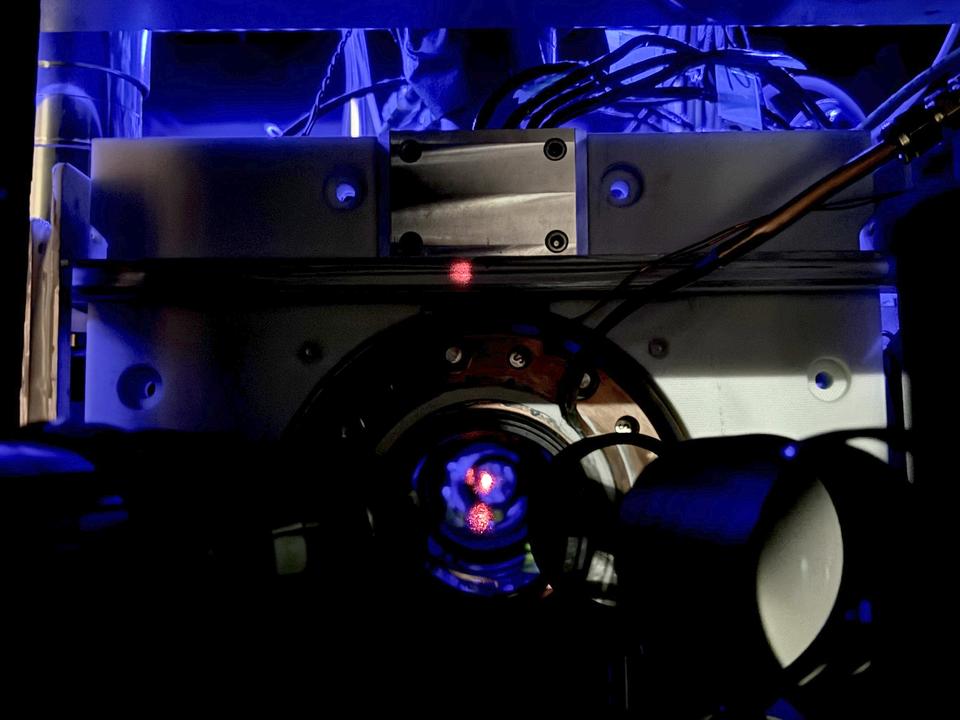
Credit: K. Palubicki/NIST
An extremely cold gas of strontium atoms is trapped in an optical lattice. The atoms are held in an ultra-high-vacuum environment. This vacuum helps preserve the atoms’ delicate quantum states. The red dot in the image is a reflection of the laser light used to create the atom trap.
The worldwide scientific community is considering redefining the second, the international unit of time, based on these optical atomic clocks.
Existing-generation atomic clocks shine microwaves on atoms to measure the second. This new wave of clocks illuminates atoms with visible light waves, which have a much higher frequency, to count out the second much more precisely.
Compared with current microwave clocks, optical clocks are expected to deliver much higher accuracy for international timekeeping — potentially losing only one second every 30 billion years.
The optical lattice can rap and measure tens of thousands of individual atoms simultaneously. Having such a large ensemble provides a huge advantage in precision. The more atoms measured, the more data the clock has for yielding a precise measurement of the second.
To achieve new record-breaking performance, the JILA researchers used a shallower, gentler “web” of laser light to trap the atoms, compared with previous optical lattice clocks. This significantly reduced two major sources of error — effects from the laser light that traps the atoms, and atoms bumping into one another when they are packed too tightly.
“This clock is so precise that it can detect tiny effects predicted by theories such as general relativity, even at the microscopic scale,” says NIST and JILA physicist Jun Ye. “It’s pushing the boundaries of what’s possible with timekeeping.”
One of the key predictions of Einstein’s general theory of relativity is that time itself is affected by gravity — the stronger the gravitational field, the slower time passes.
This new clock design can allow detection of relativistic effects on timekeeping at the submillimeter scale, about the thickness of a single human hair.
Raising or lowering the clock by that minuscule distance is enough for researchers to discern a tiny change in the flow of time caused by gravity’s effects.
This ability to observe the effects of general relativity at the microscopic scale can significantly bridge the gap between the microscopic quantum realm and the large-scale phenomena described by
More precise atomic clocks also enable more accurate navigation and exploration in space. As humans venture farther into the solar system, clocks will need to keep precise time over vast distances.
Even tiny errors in timekeeping can lead to navigation errors that grow exponentially the farther you travel.
“If we want to land a spacecraft on Mars with pinpoint accuracy, we’re going to need clocks that are orders of magnitude more precise than what we have today in GPS,” says Ye, “this new clock is a major step towards making that possible.”
The same methods used to trap and control the atoms could also produce breakthroughs in quantum computing. Quantum computers need to be able to precisely manipulate the internal properties of individual atoms or molecules to perform computations. The progress in controlling and measuring microscopic quantum systems has significantly advanced this endeavor.
By venturing into the microscopic realm where the theories of quantum mechanics and general relativity intersect, researchers are cracking open a door to new levels of understanding about the fundamental nature of reality itself.
From the infinitesimal scales where the flow of time becomes distorted by gravity, to the vast cosmic frontiers where dark matter and dark energy hold sway, this clock’s exquisite precision promises to illuminate some of the universe’s deepest mysteries.
“We’re exploring the frontiers of measurement science,” says Ye “when you can measure things with this level of precision, you start to see phenomena that we’ve only been able to theorise about until now.






